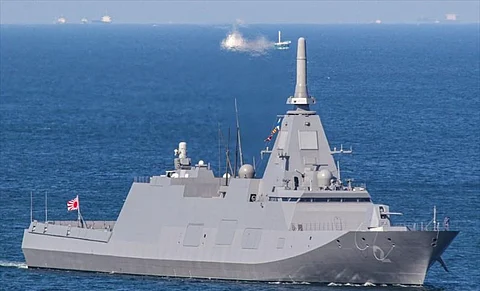

The Japan Maritime Self-Defence Force (JMSDF) recently commissioned a new stealth frigate into service in March of this year.
Built by Mitsui E&S Shipbuilding, JS Kumano is one of a planned initial batch of eight locally designed and constructed Mogami-class stealth frigates, a number that also includes six ships to be built by Mitsubishi Heavy Industries. Although Kumano is the second frigate in its class, it is the first to be commissioned, as class lead ship JS Mogami did not officially enter service until a month later.
The Mogami-class ships were developed in response to the JMSDF's need for multi-role surface combatants to replace the service's Asagiri-class destroyers and Abukuma-class destroyer escorts that were originally designed in the 1980s. The newer frigates also needed to possess nearly similar capabilities as the Akizuki-class destroyers but with smaller crew complements and fewer missile launchers.
Named after a river in central Japan, Kumano has a length of 130 metres, a beam of 16 metres, a displacement of 5,500 tonnes at full load, and accommodations for 90 crewmembers. The propulsion system consists of a Rolls-Royce MT30 gas turbine and two MAN V28/33DD STC diesel engines in a combined diesel and gas (CODAG) arrangement that delivers a speed of just over 30 knots.
The frigate's armament includes a BAE Systems 127-millimetre naval gun, Mitsubishi Type 17 anti-ship missiles, Mitsubishi Type 12 torpedoes, Raytheon RIM-116 Rolling Airframe Missiles (RAMs) and Type 03 medium-range missiles for anti-air warfare, machine guns on remote weapon stations above the bridge, and mines.
A flight deck and a hangar are available for use by an SH-60 Seahawk sonar-equipped helicopter to complement the frigate's anti-submarine capability. The ship also has space for two rigid inflatable boats (RIBs) as well as unmanned surface and underwater vehicles, which can be deployed into and recovered from the water via a stern ramp. A chaff dispenser is fitted to provide defence against guided missiles.
To achieve the desired operational capability even with a smaller number of embarked personnel compared to the Akizuki-class destroyers, Kumano relies heavily on a number of automated systems. One notable feature is an advanced integrated combat information centre developed by Mitsubishi Heavy Industries. This system consists of a large circular screen through which operators can view all navigation, propulsion, tracking, and fire control data. The same system provides the crew with a full 360 degrees of visibility through the use of cameras, enabling them to see the areas around the ship without any blind spots.
The remaining essential systems include an OPY-2 active electronically scanned array (AESA) X-band radar, fixed and towed sonars, and an OAX-3 electro-optical/infrared (EO/IR) sensor. The radar and the EO/IR sensor were supplied by Mitsubishi Electric.
| Kumano | |
| SPECIFICATIONS | |
| Type of vessel: | Frigate |
| Flag: | Japan |
| Owner: | Japan Maritime Self-Defence Force |
| Builder: | Mitsui E&S Shipbuilding, Japan |
| Hull construction material: | Steel |
| Superstructure construction material: | Steel |
| Deck construction material: | Steel |
| Length overall: | 130 metres |
| Beam: | 16 metres |
| Displacement: | 5,500 tonnes |
| Main engines: | Rolls-Royce MT30; 2 x MAN V28/33DD STC |
| Maximum speed: | 30 knots |
| Radar: | Mitsubishi Electric OPY-2 AESA |
| Other electronics: | Mitsubishi Heavy Industries combat information centre; Mitsubishi Electric electro-optical/infrared sensor |
| Armaments: | BAE Systems naval gun; Raytheon RIM-116 Rolling Airframe Missiles; Mitsubishi Type 17 anti-ship missiles; Mitsubishi Type 12 torpedoes; Type 03 surface-to-air missiles; 2 x machine guns; mines |
| Tenders: | 2 x rigid inflatable boats |
| Type of fuel: | Diesel |
| Crew: | 90 |
